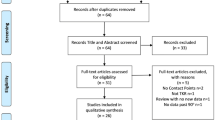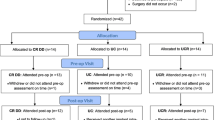Abstract
Purpose
Single radius knee implants were introduced to reduce the level of paradoxical anterior femoral translation (AFT) during mid-flexion after total knee arthroplasty. Findings from clinical and experiment studies are inconsistent, which may be due to the different loading conditions and articular conformities of the knee implants studied. The aim of this study is to analyze how variations in these two factors affect the mid-flexion stability of a single radius knee prosthesis.
Methods
Six daily activities (walking, stair ascent, stair descent, sit-to-stand, pivot turn and crossover turn), and three articular conformity ratios (low, moderate and high) were considered. The resulting AFTs from the 18 finite element models were analyzed.
Results
For low conformity knees, the worst case activity (the greatest AFT) was sit-to-stand with an AFT of 6.2 mm, while for the moderate conformity the worst case was crossover turn and pivot turn. For high conformity, all activities produced a relatively small AFT ranging from 0 mm to 1.8 mm, which more closely resembles natural knee motion. In addition, no AFT was recorded during stair ascent for all three conformities (low, moderate, high).
Conclusions
This study demonstrated that the amount of AFT is highly dependent on the activity being undertaken and the articular conformity of the knee prosthesis, and the worst case activity depends on the knee conformity. The clinical relevance of this study is that it offers valuable information towards the design of improved knee prostheses and selection of knee implants for clinical use.
Level of evidence
II.









Similar content being viewed by others
References
Abdel-Rahman EM, Hefzy MS (1998) Three-dimensional dynamic behaviour of the human knee joint under impact loading. Med Eng Phys 20(4):276–290
Arnout N, Vanlommel L, Vanlommel 2, Luyckx JP, Labey L, Innocenti B, Victor J, Bellemans J (2015) Post-cam mechanics and tibiofemoral kinematics: a dynamic in vitro analysis of eight posterior-stabilized total knee designs. Knee Surg Sports Traumatol Arthrosc 23(11):3343–3353
ASTM F3141 (2017) Standard guide for total knee replacement loading profiles
Bergmann G, Bender A, Graichen F, Dymke J, Rohlmann A, Trepczynski A, Heller MO, Kutzner I (2014) Standardized loads acting in knee implants. PLoS One 9(1):e86035
Bergmann G, Graichen F (2014) Loading of orthopedic implants. OrthoLoad2014 [cited 2014] http://www.orthoload.com
Cheng CK, Brand RA, Brown TD (1993) Knee joint force distributions in the stance phase of the human gait. Biomed Eng Appl Basis Commun 5(6):56–64
Clary CW, Fitzpatrick CK, Maletsky LP, Rullkoetter PJ (2013) The influence of total knee arthroplasty geometry on mid-flexion stability: an experimental and finite element study. J Biomech 46(7):1351–1357
DesJardins JD, Walker PS, Haider H, Perry J (2000) The use of a force-controlled dynamic knee simulator to quantify the mechanical performance of total knee replacement designs during functional activity. J Biomech 33(10):1231–1242
Godest AC, Beaugonin M, Haug E, Taylor M, Gregson PJ (2005) Simulation of a knee joint replacement during a gait cycle using explicit finite element analysis. J Biomech 38(3):265–275
Grood ES, Suntay WJ (1983) A joint coordinate system for the clinical description of three-dimensional motions: application to the knee. J Biomech Eng 105(2):136–144
Halloran JP, Easley SK, Petrella AJ, Rullkoetter PJ (2005) Comparison of deformable and elastic foundation finite element simulations for predicting knee replacement mechanics. J Biomech Eng 127(5):813–818
Hamai S, Okazaki K, Shimoto T, Nakahara H, Higaki H, Iwamoto Y (2015) Continuous sagittal radiological evaluation of stair-climbing in cruciate-retaining and posterior-stabilized total knee arthroplasties using image-matching techniques. J Arthroplast 30(5):864–869
Hollister AM, Jatana S, Singh AK, Sullivan WW, Lupichuk AG (1993) The axes of rotation of the knee. Clin Orthop Relat Res 290:259–268
Hsu WH, Fisk JA, Yamamoto Y, Debski RE, Woo SL (2006) Differences in torsional joint stiffness of the knee between genders: a human cadaveric study. Am J Sports Med 34(5):765–770
Innocenti B, Rosellini G, Pianigiani S (2017) Single-radius vs j-curved femoral designs during walking and squatting. ESB-ITA. ISBN: 978-88-6296-000-7
ISO 14243-1 (2009) Implants for surgery. Wear of total knee joint prostheses. Loading and displacement parameters for wear-testing machines with load control and corresponding environmental conditions for test
Kessler O, Dürselen L, Banks S, Mannel H, Marin F (2007) Sagittal curvature of total knee replacements predicts in vivo kinematics. Clin Biomech (Bristol Avon) 22(1):52–58
Lin KJ, Huang CH, Liu YL, Chen WC, Chang TW, Yang CT, Lai YS, Cheng CK (2011) Influence of post-cam design of posterior stabilized knee prosthesis on tibiofemoral motion during high knee flexion. Clin Biomech (Bristol Avon) 26(8):847–852
Louisia S, Siebold R, Canty J, Bartlett RJ (2005) Assessment of posterior stability in total knee replacement by stress radiographs: prospective comparison of two different types of mobile bearing implants. Knee Surg Sports Traumatol Arthrosc 13(6):476–482
Massin P, Boyer P, Sabourin M (2012) Less femorotibial rotation and AP translation in deep-dished total knee arthroplasty. An intraoperative kinematic study using navigation. Knee Surg Sports Traumatol Arthrosc 20(9):1714–1719
Minoda Y, Ikebuchi M, Mizokawa S, Ohta Y, Nakamura H (2016) Mobile-bearing TKA improved the anteroposterior joint stability in mid-flexion range comparing to fixed-bearing TKA. Arch Orthop Trauma Surg 136(11):1601–1606
Pinskerova V, Johal P, Nakagawa S, Sosna A, Williams A, Gedroyc W, Freeman MA (2004) Does the femur roll-back with flexion? J Bone Joint Surg Br 86(6):925–931
Shimizu N, Tomita T, Yamazaki T, Yoshikawa H, Sugamoto K (2013) In vivo movement of femoral flexion axis of a single-radius total knee arthroplasty. J Arthroplast 29(12):2407–2411
Stoddard JE, Deehan DJ, Bull AM, McCaskie AW, Amis AA (2013) The kinematics and stability of single-radius versus multi-radius femoral components related to mid-range instability after TKA. J Orthop Res 31(1):53–58
Taylor MJ, Dabnichki P, Strike SC (2005) A three-dimensional biomechanical comparison between turning strategies during the stance phase of walking. Hum Mov Sci 24(4):558–573
Uvehammer J, Kärrholm J, Brandsson S (2000) In vivo kinematics of total knee arthroplasty. Concave versus posterior-stabilised tibial joint surface. J Bone Joint Surg Br 82(4):499–505
Van Stralen RA, Heesterbeek PJ, Wymenga AB (2015) Different femorotibial contact points between fixed- and mobile-bearing TKAs do not show clinical impact. Knee Surg Sports Traumatol Arthrosc 23(11):3368–3374
Walker PS, Lowry MT, Kumar A (2014) The effect of geometric variations in posterior-stabilized knee designs on motion characteristics measured in a knee loading machine. Clin Orthop Relat Res 472(1):238–247
Wang H, Simpson KJ, Chamnongkich S, Kinsey T, Mahoney OM (2008) Biomechanical influence of TKA designs with varying radii on bilateral TKA patients during sit-to-stand. Dyn Med 13(7):12
Wolterbeek N, Nelissen RG, Valstar ER (2012) No differences in in vivo kinematics between six different types of knee prostheses. Knee Surg Sports Traumatol Arthrosc 20(3):559–564
Acknowledgements
The authors would like to thank Colin McClean for his assistance with proofreading this manuscript.
Funding
This study was supported by the Grant from the Chinese National Science and Technology Program (National Key Research and Development Plan) (Grant number: 210YBXM2016110002).
Author information
Authors and Affiliations
Corresponding author
Ethics declarations
Conflict of interest
There’s no conflict of interest.
Ethical approval
This study dealt with published data only, no ethical approval was needed.
Rights and permissions
About this article
Cite this article
Wang, XH., Song, DY., Dong, X. et al. Motion type and knee articular conformity influenced mid-flexion stability of a single radius knee prosthesis. Knee Surg Sports Traumatol Arthrosc 27, 1595–1603 (2019). https://doi.org/10.1007/s00167-018-5181-2
Received:
Accepted:
Published:
Issue Date:
DOI: https://doi.org/10.1007/s00167-018-5181-2




